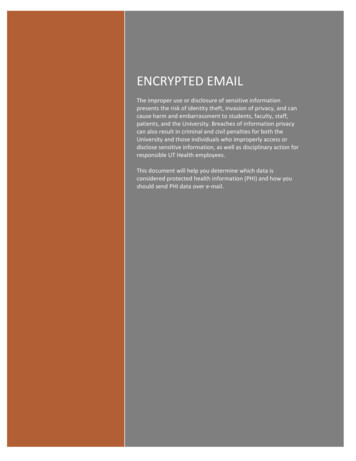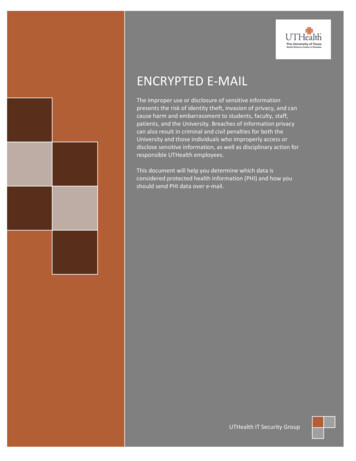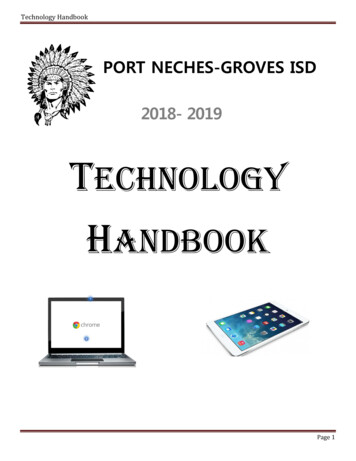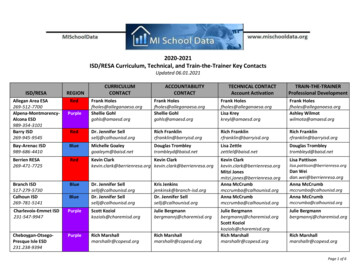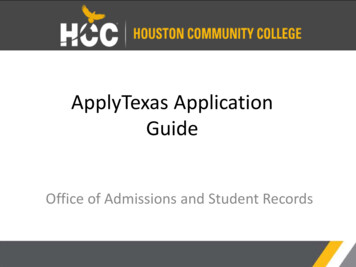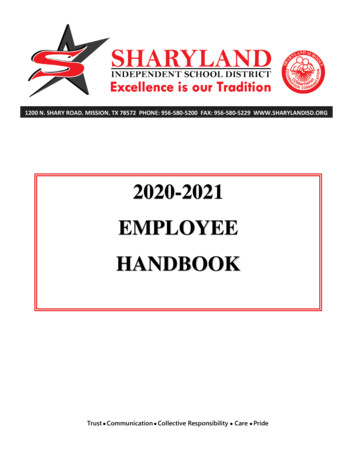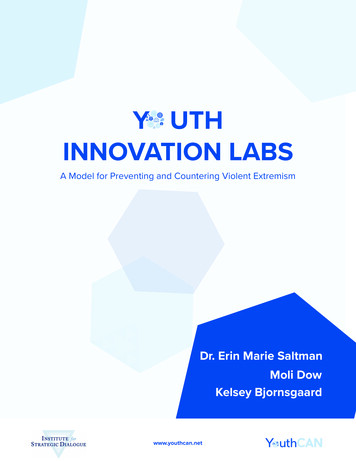
Transcription
Y UTHINNOVATION LABSA Model for Preventing and Countering Violent ExtremismDr. Erin Marie SaltmanMoli DowKelsey Bjornsgaardwww.youthcan.net
AboutThe Youth Civil Activism Network (YouthCAN) is designed to upscale and optimise grassroots efforts to combatviolent extremism of all forms. It connects a wide array of youth activists from around the world, including artists, techentrepreneurs, civil society leaders, youth workers, filmmakers, cartoonists, students and innovators. The network waslaunched to enable an ongoing and international exchange of practices and know-how, and to foster collaborationand co-creation between its members. Through the network, young people’s needs and views are also representedto policy makers.YouthCAN is a global network. First launched to Europe at the Youth Against Violent Extremism conference in Oslo,June 2015. The network has since expanded with Commonwealth YouthCAN launched in Malta, November 2015. Thenetwork currently has over 550 members from 85 countries.YouthCAN is managed by the Institute for Strategic Dialogue (ISD). ISD specialises in creating unique networksand partnerships to innovate and hypercharge countering violent extremism (CVE) efforts both online and offline.As a think tank, all of ISD’s research is action-oriented and leads to the development of project pilots, which in turnhave rigorous methods and evaluation processes to assess what is working and what might be re-tailored or shifted.Counter-narrative development and strategic communication projects are at the heart of ISD’s efforts. Over time, ISDhas built networks of ‘credible messengers’ and partnered with private sector organisations to ensure that the supportis given to target and scale effective counter-narrative projects sustainably, and sensitively. ISD, with support fromleading social media companies such as Google, Twitter, and Facebook, is also leading a data-driven approach. Byturning analysis into action, and ‘learning by doing’, ISD are at the forefront of a new approach to countering extremism– one that breaks free from reinforcing assumptions about extremism without demonstrating what works to counter it.About the authorsDr Erin Marie Saltman is a Senior Researcher at the Institute for Strategic Dialogue. She manages research and projectdevelopment on ISD's civil society CVE programmes which include: the Youth Civil Activism Network (YouthCAN), theOnline Civil Courage Initiative (OCCI), and the Women and Extremism (WaE) programme. Dr Saltman’s background andexpertise includes both far-right and Islamist extremist processes of radicalisation, counter-extremism and politicalsocialisation within a range of regional and socio-political contexts. Her primary research looks at online extremism,gender dynamics, and cognitive openings for preventing and countering violent extremism.Moli Dow is a Project Coordinator at ISD, working on both the Youth Civil Activism Network (YouthCAN) and One toOne initiative. She manages network growth and development for YouthCAN. Moli’s experience ranges from bothupstream engagement with civil society to downstream targeted messaging and online intervention for counteringviolent extremism. Having previously worked as a researcher at the Richardson Institute at the University of Lancaster,Moli’s expertise includes both qualitative and quantitative methods to give an interdisciplinary approach to theinitiatives she engages with.Kelsey Bjornsgaard is a Programme Associate at the Institute for Strategic Dialogue. She runs counter-narrative contentdevelopment and is responsible for organising ISD’s regional Innovation Labs. She works closely with YouthCAN tofacilitate the development and launch of counter-narrative content and initiatives produced at labs.AcknowledgementsThe authors would like to thank Sebastian Feve, Ross Frenett, Tanya Silverman and Henry Tuck for their contributions to the initial development of theInnovation Lab model, as well as Zahed Amanullah, Jonathan Birdwell, Caitlin MacDonald and Jas Kirt for their editorial input in this publication. Specialthanks also go to the Facebook team and the Commonwealth Secretariat Youth Division for their ongoing collaboration with YouthCAN and participationin Youth Innovation Labs.YouthCAN gives gratitude to both the Norwegian Ministry of Foreign Affairs and the Foreign Commonwealth Office for their support in the growth andcontinuation of YouthCAN.Lastly, we would be nothing without our incredible and dedicated YouthCAN members. We have learned so much from you and look forward tocontinuing our work together.All errors and omissions are the sole responsibility of the authors.Copyright 2016 Institute for Strategic Dialogue, All rights reserved. Any copying, reproduction or exploitation of the whole or any part of this documentwithout prior written approval from the Institute for Strategic Dialogue is prohibited.This material is offered free of charge for personal and non-commercial use, provided the source is acknowledged. For commercial or any other use,prior written permission must be obtained from the Institute for Strategic Dialogue. In no case may material be sold, altered, or rented. The Institutedoes not generally take positions on policy issues. This views expressed in this publication are those of the authors and do not necessarily reflect theviews of the Institute for Strategic Dialogue.
Table of ContentsSUMMARY3INTRODUCTION6 88The Challenge of Online ExtremismEncouraging Activism Through Youth Innovation LabsFACILITATING A YOUTH INNOVATION LAB10 11151718Universal and RegionalThe Participants: Cross Sector CollaborationActive Learning and Co-CreationStructure of a Youth Innovation LabEVALUATING A YOUTH INNOVATION LAB22 2324Evaluating Participants’ Skills and ExperienceEvaluating Youth Innovation Lab CampaignsTHE PRODUCT: COUNTER-NARRATIVE CAMPAIGNS26 27282829The Truth about Halal!Links4PeaceHumans of TomorrowNo To TerrorCONCLUSIONS AND RECOMMENDATIONS31BIBLIOGRAPHY33ADDITIONAL RESOURCES34GLOSSARY35
SUMMARY
SummaryThe following publication discusses the development, implementation and evaluation ofYouth Innovation Labs conducted by the Youth Civil Activism Network (YouthCAN). YouthInnovation Labs are immersive, activist-led events that provide a space for innovation, cocreation and learning while giving participants the contacts, tools and resources needed todevelop counter-narrative campaigns for preventing and countering violent extremism.Why do we need Youth Innovation Labs? Over the last few years global attention has beenpaid to violent extremist organisations like ISIS, Boko Haram and a range of far-right groups.As a reaction, in 2015 there was an uprising of young voices convening on the topic of peacebuilding, discussing how young people can be supported in their efforts in preventing andcountering violent extremism (PVE and CVE). Youth summits, supported by governmentsand international bodies, took place in different parts of the world, engaging a wide range ofyoung activists.1 The majority of these events reached similar conclusions about the need toactively involve young people in PVE and CVE. These events spanned regions, ethnicities,ideologies, gender and faiths to amplify the voices of young people.Two common conclusions reached at these events were:12Youth activists internationally need safe spaces for dialogue and creativedevelopment.There is a need for different sectors to proactively support youth-led initiatives,especially government and tech sectors.YouthCAN has been able to connect youth activists with local artists, creatives and techsector exports through Youth Innovation Labs. These labs serve to facilitate the creationof counter-narrative campaigns and initiatives that challenge or provide alternatives to theideologies, narratives and propaganda of violent extremists.YouthCAN Youth Innovation LabsConnect youthactivists, with localartists, creatives andtech-sector expertsFacilitate the creationof counter-narrativecampaignsProvide an alternatives tothe ideologies, narrativesand propaganda ofviolent extremists1The largest of these international youth events were the Youth Against Violent Extremism Summit in Oslo (June 2015), the Global Forum on Youth, Peace andSecurity in Amman (August 2015) and the Global Youth Summit Against Violent Extremism at the UNGA Summit in New York (September 2015).4 Institute for Strategic Dialogue
After carrying out regional labs in Amsterdam, Kigali, Madrid and Budapest, YouthCAN hassix key lessons to share with organisations and practitioners developing similar events.123456Size matters: Smaller and medium-sized events (between 25 and 35) seem toproduce better results.Everyone is equal: Participants come from a wide range of backgrounds andexperience. However, the format of a lab and content should not assume previousknowledge or bias.Make it local: Tailor your event to the community or region you are working with.Give time for ideas to materialise: Give time for concepts to turn into tangibleprojects.Follow up is crucial: To ensure output, follow up is necessary after the event.Do no harm: It is important to take a ‘Do No Harm’ approach when encouraging PVEand CVE engagement.YouthCAN’s ultimate goal is to engage young people and provide them with the tools theyneed to create effective content aimed at challenging hate speech and violent extremism.We hope that this model will help other practitioners, activists and policy makers grow andexpand their own efforts to increase the powerful voice of young people in efforts towardspreventing and countering violent extremism.Youth Innovation Labs 5
INTRODUCTION
IntroductionThe following publication discusses the development, implementation and evaluationof Youth Innovation Labs. Labs are immersive, activist-led events that create a secureenvironment to facilitate capacity-building while giving participants the contacts, tools andresources needed to develop strategic campaigns for preventing and countering violentextremism. When looking at larger international efforts to prevent and counter violentextremism, youth are often discussed as either part of the problem or as an ‘at risk’ cohortthat needs safeguarding.2 Unfortunately, these positions give little agency to young activistsand provides little support for proactive youth initiatives.The challenge is involving youth as part of the solution. There have been some attemptsto do this through conferences, hackathons3 and training programmes. The problem withthese events is that they tend to either focus purely on knowledge exchanges, or solely oncampaign development and they rarely have diligent follow-up or support after the event.Thus, labs work with a youth-led approach, combining knowledge exchanges with actionoriented output. Capacity building is developed alongside campaign and initiative creation.The Institute for Strategic Dialogue (ISD) initially developed and delivered the Innovation Labmodel through capacity building workshops in Indonesia and Kenya. While ISD InnovationLabs have been organised for a range of audiences, this publication focusses on theimplementation of Youth Innovation Labs involving young people through the Youth CivilActivism Network (YouthCAN).Between June 2015 and April 2016 YouthCAN hosted four Youth Innovation Labs, specificallytailored for its youth network.4 All labs resulted in completely original counter-narrativeproducts launching new youth-led initiatives to wide audiences on social media platforms.YouthCAN and ISD are currently supporting the progression of these campaigns, with ISD’scounter-narrative team working with the lab participants to enhance and develop theirinitiatives.The purpose of this publication is to share the methodology and structure that YouthCANhas developed, as well as the best-practices and outcomes from YouthCAN’s work withyoung activists and creatives.2See: Youth Against Violent Extremism: Findings and Conclusions, (Oslo: Youth Against Violent Extremism Summit, 4 June 2015). See also: Amman YouthDeclaration on Youth, Peace and Security, (Amman: Global Youth Forum on Youth, Peace and Security, 22 August 2015), TH%20DECLARATION.pdf .3S. Leckart, ‘The Hackathon is On: Pitching and Programming the Next Killer App’, Wired Magazine, (February 2012), http://www.wired.com/2012/02/ffhackathons/all/1 .4A detailed break down and in-depth examination of YouthCAN Labs can be found in the next section.Youth Innovation Labs 7
The Challenge of Online ExtremismExtremist groups like ISIS have effectively used social media to spread their propagandaand recruit supporters from around the world. Utilising savvy audio-visual content andtechnical resources, extremist groups tailor their messages to specific audiences, includingmen or women, local citizens or foreign supporters. Much of extremist propaganda is nowprofessionalised, with strong artistic capabilities coupled with marketing strategies. Far-rightextremist groups across Europe and the US - such as the English Defence League in Britain,Golden Dawn in Greece, or PEGIDA in Germany - have also utilised potential benefits onlinetools have to offer.5 As the vast majority of far-right extremist campaigns focus on recruitingdomestic support, these groups leverage mediums such as Facebook and Twitter, not onlyto increase their reach and followers, but also as an aid in organising their offline activities.The need to counter the increasingly professional propaganda campaigns created by violentextremist groups is apparent. Recent research has demonstrated the substantial disparitybetween extremist groups and those who work to counter them.6 Typically, past approacheshave focused on removing content with passive ‘take down’ policies. However, with 5 billionnew items of content added to Facebook each day, 100 hours of videos uploaded to YouTubeevery minute and 6,000 tweets per second on Twitter, ‘take down’ approaches are only partof the solution. There is also a need to create, produce and disseminate similarly compellingcontent that directly and indirectly undermines the arguments of extremist groups.However, those best suited to deliver counter-narrative campaigns often struggle to havetheir voices heard. Credible messengers – such as former extremists, survivors of extremistviolence and the young people whom the majority of these campaigns are targeted towards– often lack the necessary funds, skills and support to effectively launch their campaigns.YouthCAN is an initiative aimed at giving credible messengers, in this case young activistswho know what messages will resonant with their generation, the tools and support theyneed to create compelling content effectively and at scale.Encouraging Activism Through Youth Innovation LabsYouthCAN’s Youth Innovation Labs aim to give young people the skills and knowledgethey need to create effective counter-narrative campaigns and initiatives. Too often, youngpeople are seen as part of the problem, rather than the solution.5Ramalingam, V. Old Threat, New Approach: Tackling the Far Right Across Europe, (London: Institute for Strategic Dialogue, 2013), s/2016/03/OldThreatNewApproach 2014.pdf6Countering Violent Extremism: Understanding the Role of Former Extremists and Counter Messaging, (London: Institute for Strategic Dialogue, 2015), s/2016/02/Formers brochure - small.pdf .8 Institute for Strategic Dialogue
As said in the Youth Action Agenda to Prevent Violent Extremism and Promote Peace:Many Counter Violent Extremism initiatives frame youth as either perpetratorsof violent extremism or as possible victims of recruitment into violent groups.However, this narrative fails to capture the fact that most young people are partof the solution. They are not turning to violence. Young people around the worldare working to build peace and prevent violent extremism.7Youth Innovation Labs were developed in recognition of the power that young people’svoices can have in tackling these issues. These labs bring activists together to connect andengage effectively through regional workshops. The YouthCAN team, including counternarrative experts and network specialists, train participants in skills which can then betranslated to both online and offline engagement. These labs therefore act as the firststep towards building an internet-savvy civil society with the knowledge and capacity toeffectively challenge extremism.7Youth Action Agenda to Prevent Violent Extremism and Promote Peace (New York City: Global Youth Summit Against Violent Extremism, 28 September 2015), NAL-Youth-Action-Agenda-1.pdf .Youth Innovation Labs 9
FACILITATING AYOUTH INNOVATION LAB
Facilitating a Youth Innovation LabThis section outlines the key guidelines to ensure the curation and running of asuccessful Youth Innovation Lab, including regional representation, participantselection and a lab’s structure.Universal and RegionalYouth Innovation Labs were developed to be compatible in a wide range of national andregional contexts and to audiences coming from a variety of backgrounds. The labs aredesigned to ensure that everyone can start at the same level, with nothing assumed ofthem other than their willingness to engage. Participants are encouraged to bring theirown experience and expertise to the table, whether that is in peacebuilding, counteringviolent extremism, combating hate speech, technological expertise or a creative talent.The Innovation Lab is a highly versatile model with almost universal applicability; however,extremism affects different regions differently and labs must reflect this diversity.In order to fully engage participants, each individual lab should take a regional approachthat offers a focused examination of the problem and discusses relevant examples ofinnovative solutions with distinct localised contexts in mind. Between June 2015 and April2016, YouthCAN held four Youth Innovation Labs:AMSTERDAM, OCTOBER 2015:Hosted 38 participants from theNetherlands, Germany, Belgium andSwitzerland.MADRID, MARCH 2016:Hosted 35 participants from Spain,Portugal, Italy, Greece and France.KIGALI, FEBRUARY 2016:Hosted 35 participants from 11countries in the African region.BUDAPEST, APRIL 2016:Hosted 33 participants from Hungary,Poland, Czech Republic, Slovakia,Austria and Romania.Youth Innovation Labs 11
The following visualisation shows the regions covered in the first four Youth Innovation Labs:Figure 1: Regional Representation in First Four Youth Innovation LabsAMSTERDAMKIGALIBUDAPESTMADRIDCountries Represented at Each Regional Youth Innovation LabsWhile the structure of each lab remains the same, the examples given to expose extremistpropaganda, as well as examples showing how grassroots efforts are using innovation tocounter extremism, are tailored to the regional audience. For example, in the Amsterdam12 Institute for Strategic Dialogue
Lab the examples of extremist propaganda and counter-extremist initiatives were differentto those shared in Rwanda, while those shown in Madrid differed from Budapest.Figure 2: Examples of Regional Content Shared at Youth Innovation LabsRWANDAIn Rwanda, for an Innovation Lab with participants coming from 14 African countries, non-violent propagandafrom Boko Haram was shared alongside the Nigerian #BringBackOurGirls counter-narrativesHUNGARYIn comparison, in Hungary, for an Innovation Lab given to Central and Eastern European participants, Hungarianfar-right propaganda was shown alongside Polish anti-neo-Nazi counter-narrativesDiscussing regional examples helps start a dialogue among the groups and allows participantsto start deconstructing extremist propaganda to help them construct their own PVE and CVEcampaigns and initiatives. The extremist material shared
About The Youth Civil Activism Network (YouthCAN) is designed to upscale and optimise grassroots efforts to combat violent extremism of all forms. It connects a wide array of youth activists from around the world, including artists, tech entrepreneurs, civil society leaders, youth w
